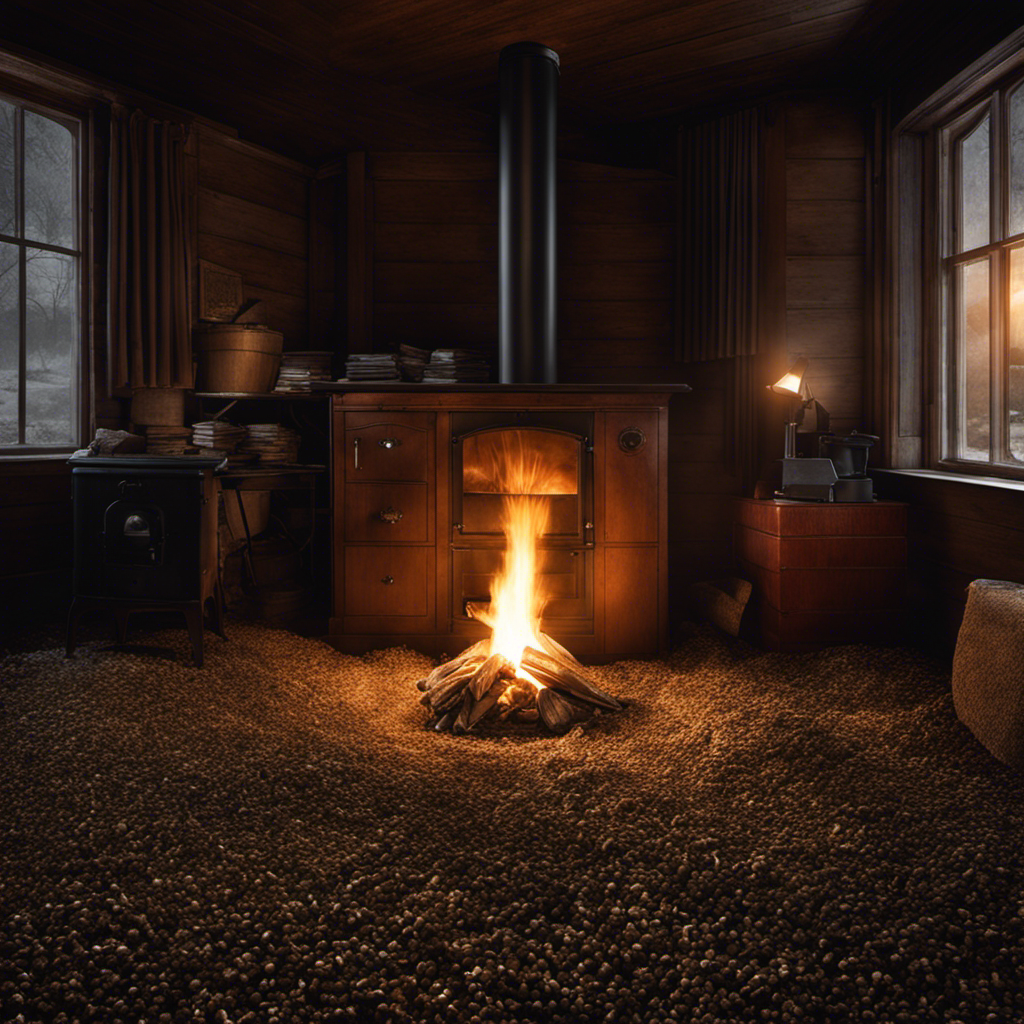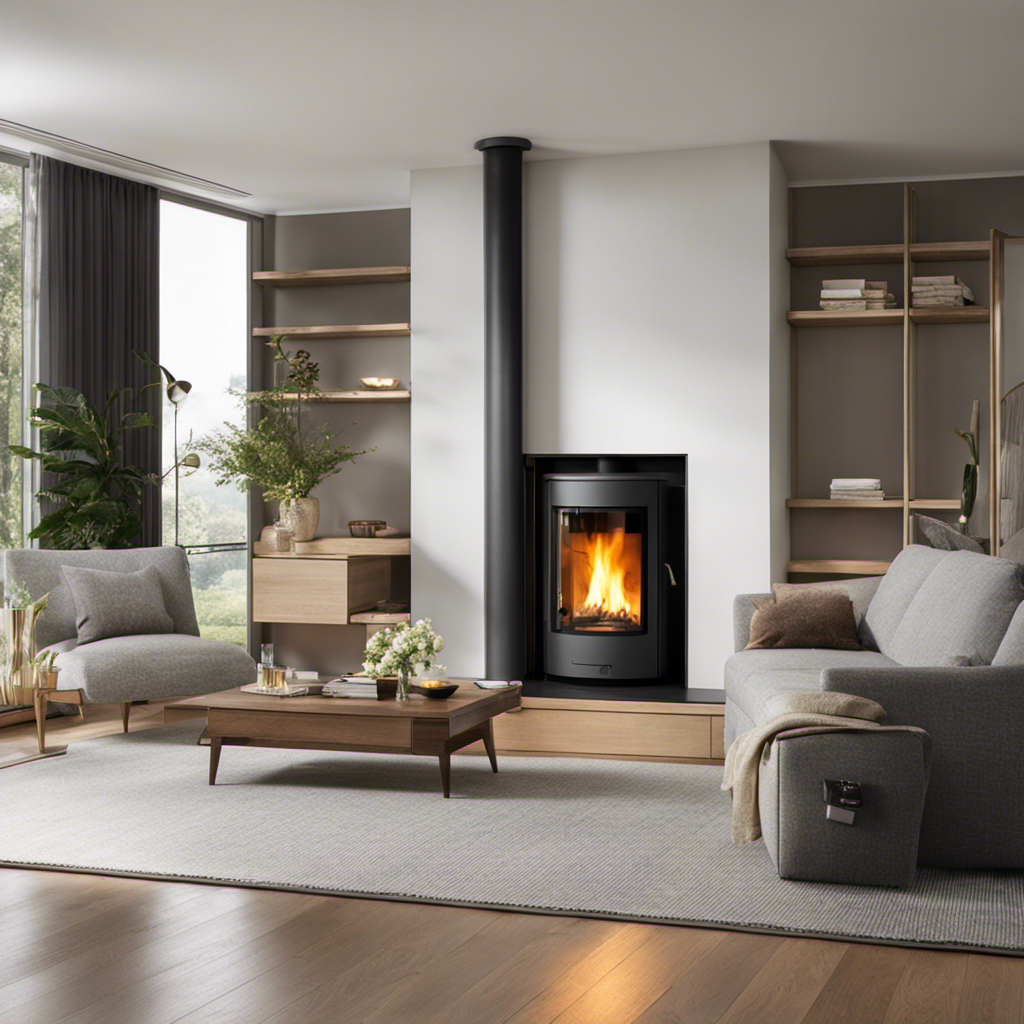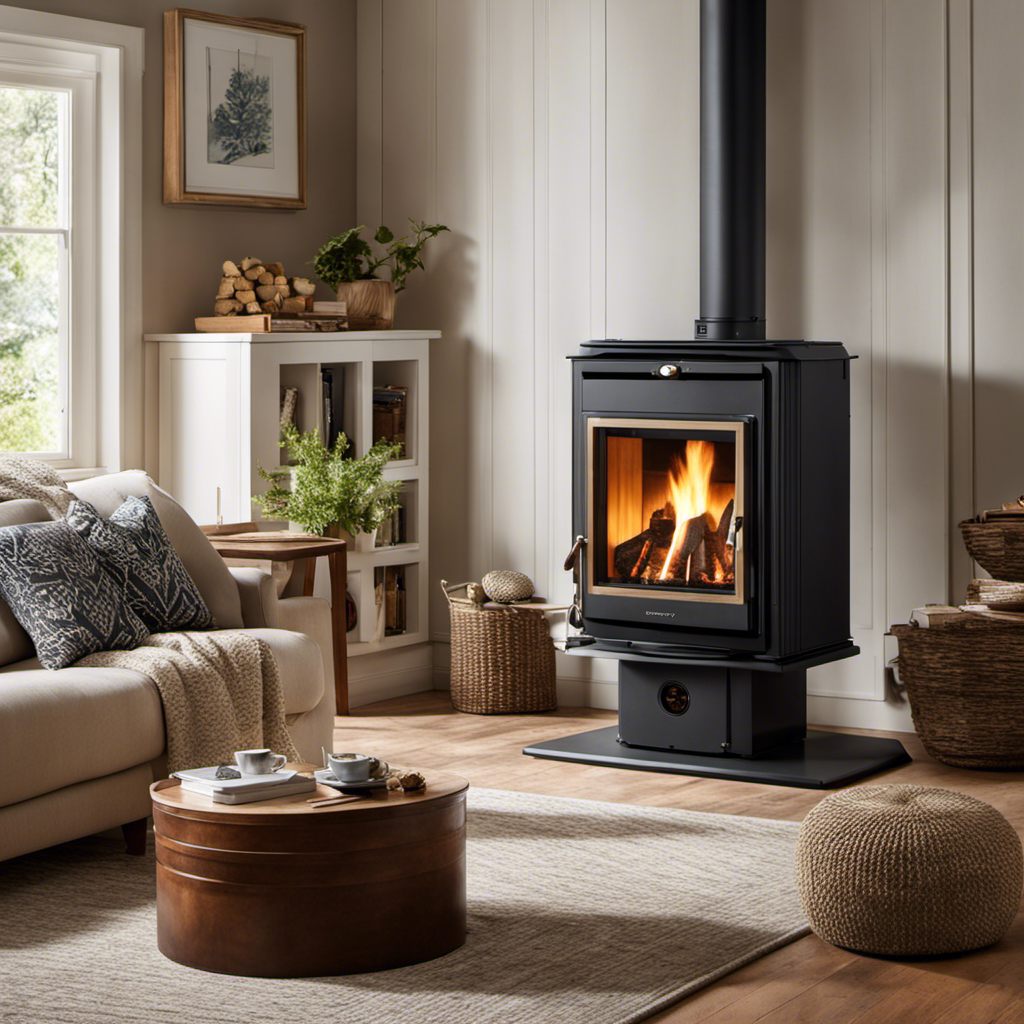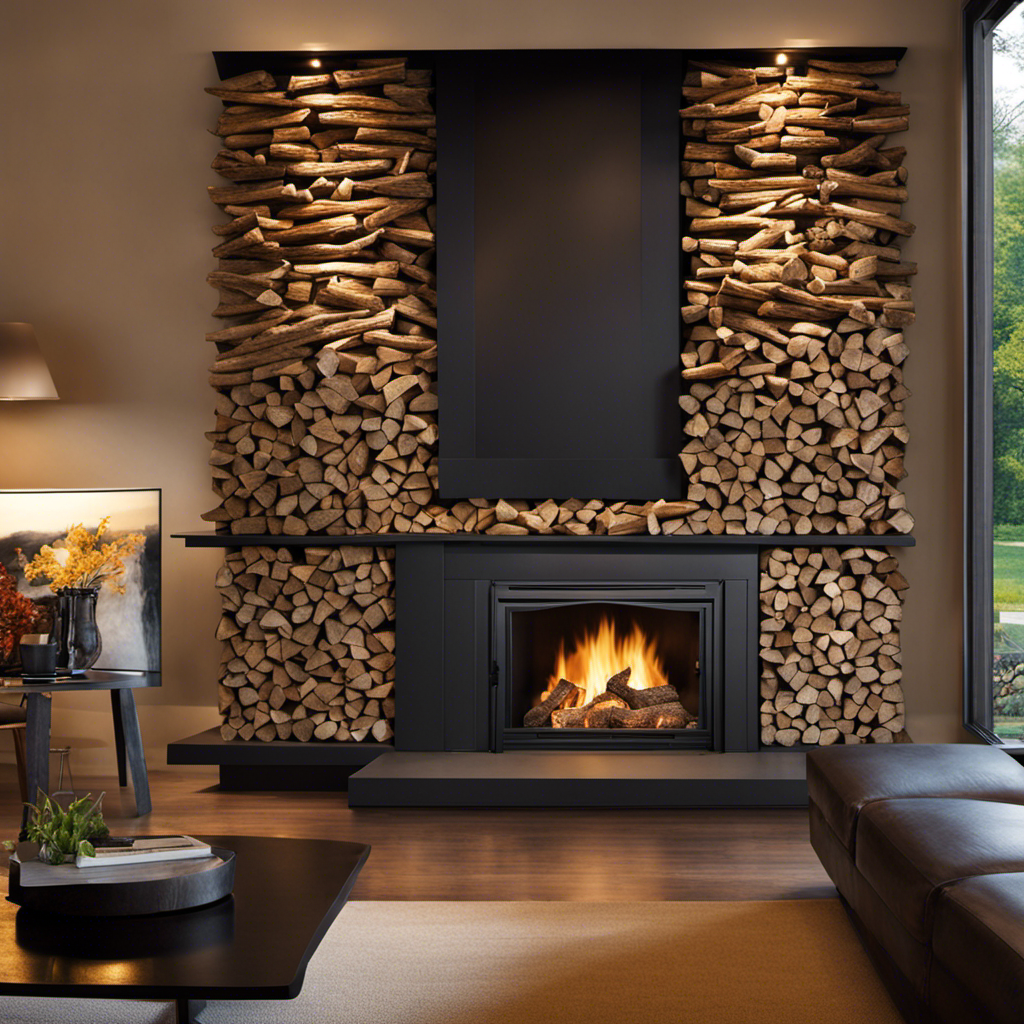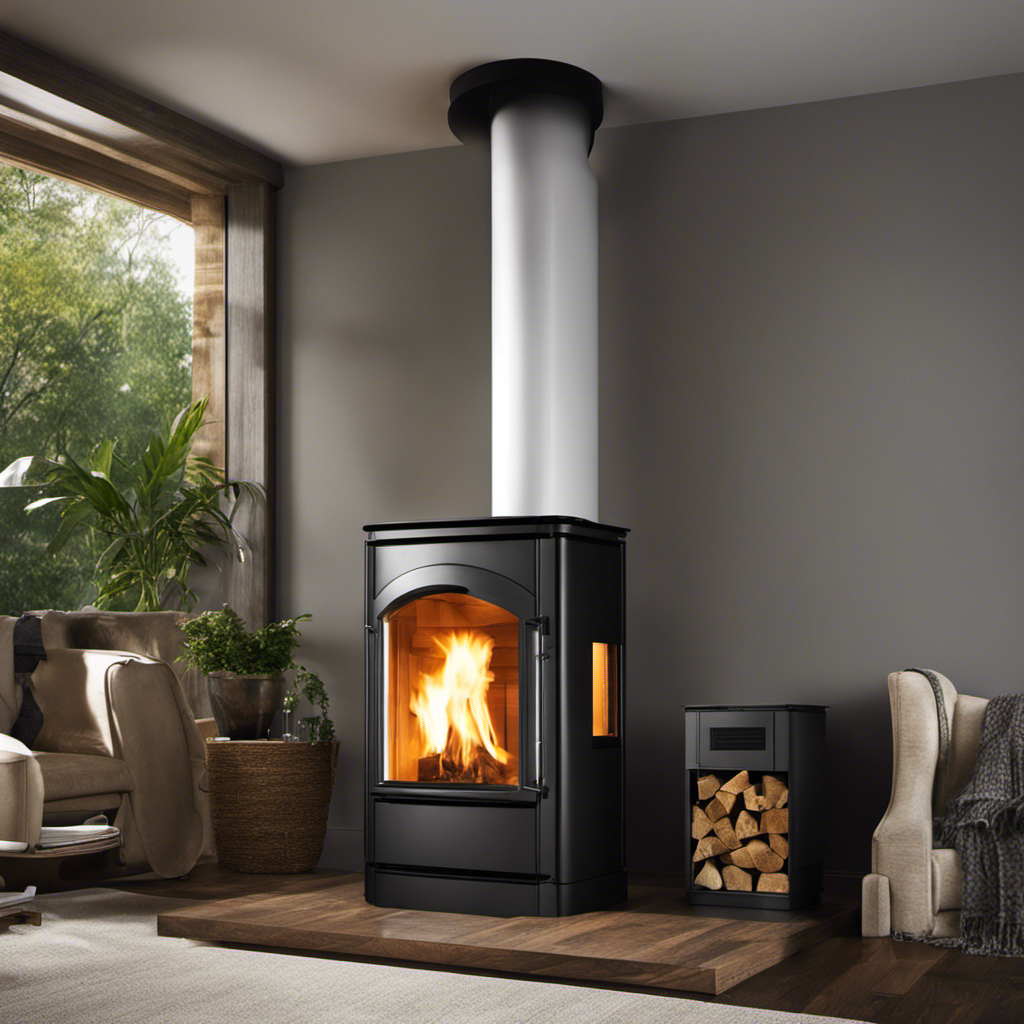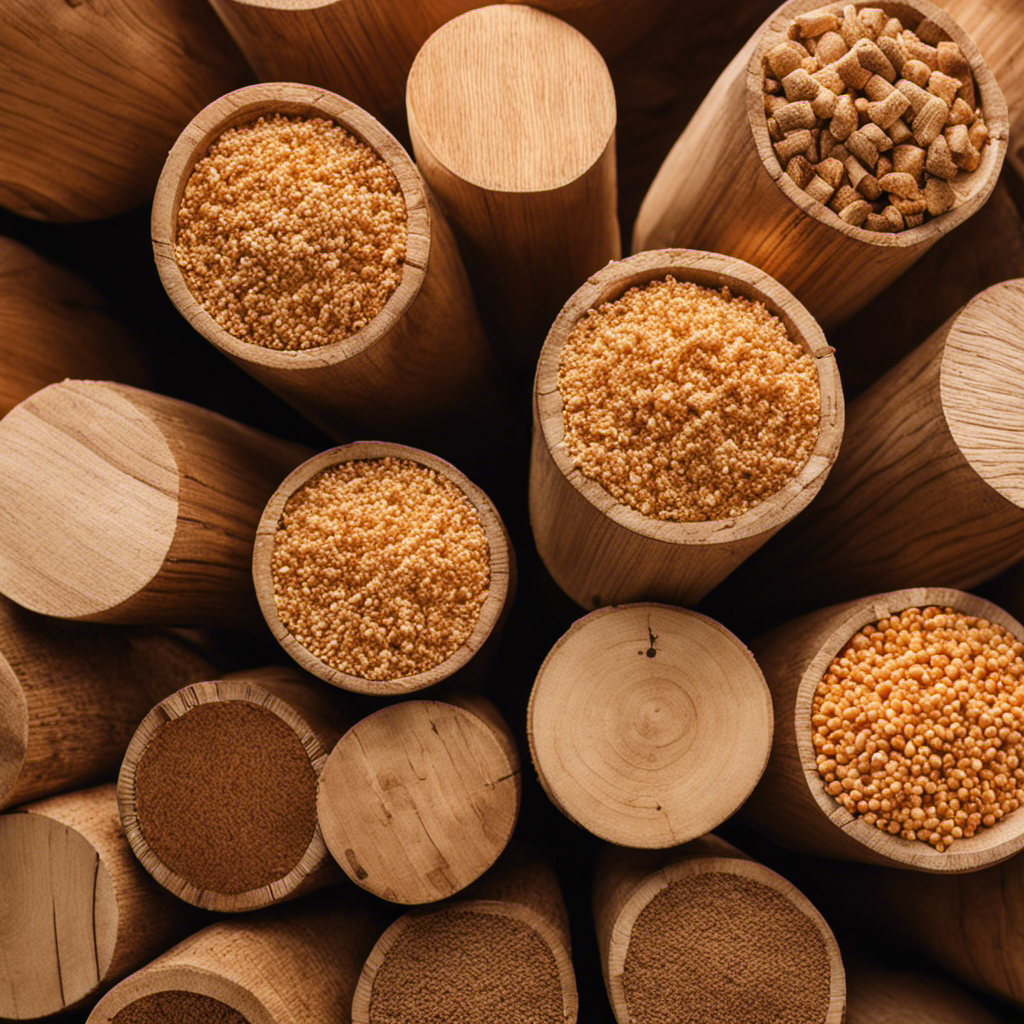Does the sight of a messy pellet stove first thing in the morning bother you? We’ve experienced it ourselves. The annoyance of handling unburnt pellets, too much ash accumulation, and blocked burn pots is something we know all too well. And it’s exactly for this reason that we’re here to offer solutions for these issues.
In this article, we’ll provide practical solutions to overcome these nightmares. From checking vents for obstructions to troubleshooting vacuum leaks, we’ll guide you towards a properly functioning pellet stove.
Say goodbye to those pellet piles and hello to a smoother burning experience.
Key Takeaways
- Insufficient airflow can cause pellets to smolder instead of burning properly.
- Excessive ash buildup in the burn pot can prevent the fire from getting hot enough.
- Clogged burn pot can lead to pellet piles and hinder proper stove function.
- Vacuum leaks and blocked exhaust pipes can disrupt airflow and cause pellet piles.
Insufficient Airflow
When there’s insufficient airflow in our pellet stove, the pellets smolder instead of burning hot. This can be a frustrating issue for pellet stove owners, but there are troubleshooting tips and maintenance recommendations that can help resolve the problem.
First, check the exhaust and intake vents for any obstructions. Clear out any debris or blockages that may be preventing proper airflow.
Additionally, it’s important to clean or replace the air filter if necessary. A dirty or clogged air filter can restrict airflow and lead to smoldering pellets.
If the issue persists, it may be beneficial to consider professional chimney cleaning or inspection to ensure there are no underlying issues causing the lack of airflow.
Excessive Ash Buildup
To prevent the fire from getting hot enough, we regularly empty the ash pan and keep the area around the stove clean. Excessive ash buildup can hinder the performance of a pellet stove and lead to inefficient burning.
Here are some tips and tricks to prevent excessive ash buildup:
-
Empty the ash pan regularly: Depending on stove usage, the frequency of ash pan emptying may vary. Emptying the ash pan prevents ash accumulation in the burn pot.
-
Keep the area around the stove clean: Maintaining a clean and debris-free area around the pellet stove ensures proper airflow and prevents ash from spreading.
-
Clean the burn pot: If there’s already a lot of ash in the burn pot, clean it before using the stove again. This will prevent excessive ash buildup.
Clogged Burn Pot
We can clear a clogged burn pot by removing it from the stove and using a stiff brush or vacuum cleaner hose to remove any build-up. Cleaning techniques like this are essential for troubleshooting pellet stove issues.
When the burn pot becomes clogged with ashes or debris, pellets can pile up and prevent proper burning. By removing the burn pot and using a brush or vacuum cleaner hose, we can effectively clear any build-up. It’s important to scrape stubborn bits with a putty knife or sharp object if necessary.
Once the burn pot is clear, reattach it and restart the fire. Regular maintenance and cleaning of the burn pot will help ensure that the pellet stove operates efficiently and without any issues.
Vacuum Leak
Our troubleshooting efforts revealed that a vacuum leak can lead to insufficient airflow in the pellet stove, resulting in smoldering instead of proper burning. Common signs and symptoms of a vacuum leak in a pellet stove include weak flame, slow or no ignition, and a build-up of unburned pellets in the burn pot.
To troubleshoot and fix a vacuum leak, start by visually inspecting the hoses and pipes connected to the pellet stove for any cracks or holes. Repair minor leaks with glue or tape, but for more severe leaks, it’s best to replace the entire hose or pipe.
Additionally, ensure that the exhaust and intake vents are clear of any obstructions. By addressing these issues, you can restore proper airflow and prevent smoldering in your pellet stove.
Blocked Exhaust
A clean exhaust pipe is crucial for proper function of our pellet stove, as a blocked exhaust can disrupt airflow and lead to smoldering. To prevent this issue, regular cleaning of the pellet stove’s exhaust pipe is necessary.
Start by turning off the stove and allowing it to cool down completely.
Next, disconnect the exhaust pipe from the stove.
Use a chimney brush or a long flexible brush to remove any soot or debris from the inside of the pipe.
You can also use a vacuum cleaner with a brush attachment to clean the pipe thoroughly.
Once the pipe is clean, reattach it to the stove securely.
Regular maintenance of the exhaust pipe will ensure efficient airflow and prevent pellet pile-ups.
Ignition Problems
Ignition problems can be frustrating for us as they prevent the stove from starting and heating our home efficiently. However, with some troubleshooting techniques and maintenance tips, we can overcome these challenges.
Firstly, check the power supply to ensure it’s connected and working properly.
Next, inspect the igniter for any signs of damage or wear and tear. Clean or replace it if necessary.
Additionally, make sure the fuel hopper is filled with clean, dry pellets.
Check the fuel delivery system for any blockages or clogs that may be hindering the ignition process.
Lastly, consider scheduling regular professional maintenance to ensure all components are in good working condition.
Pellet Quality Issues
Dealing with low-quality pellets can be frustrating as they often result in poor stove performance and inefficient heating. To avoid pellet quality issues, proper storage is essential.
Pellets should be stored in a dry, well-ventilated area, away from moisture and pests. Consider investing in airtight containers or pellet storage bins to maintain their quality.
Additionally, troubleshooting pellet stove igniters can help address ignition problems. Start by checking the igniter for any signs of damage or malfunction. Clean the igniter and ensure it’s properly connected to the stove.
If the igniter still fails to ignite the pellets, it may need to be replaced. Consult the manufacturer’s instructions or seek professional assistance to ensure proper troubleshooting and maintenance of your pellet stove igniter.
Inaccurate Temperature Control
Our frustration grows when the temperature control on our pellet stove is inaccurate. Troubleshooting temperature sensors is crucial in resolving this issue.
Start by checking if the temperature sensor is clean and free of debris. A dirty sensor can give false readings, leading to temperature inconsistencies. Ensure that the sensor is securely connected to the control panel. Loose connections can also affect accuracy.
Another factor to consider is the placement of the thermostat. Understanding the impact of thermostat placement is key in achieving accurate temperature control. Avoid placing the thermostat near drafty areas, direct sunlight, or heat sources. These factors can interfere with the sensor’s ability to accurately measure room temperature.
Excessive Noise
Experiencing excessive noise can be frustrating, especially when trying to enjoy the warmth of our pellet stove. If you’re dealing with a noisy pellet stove, there are a few troubleshooting steps you can take to fix the issue. Here are some tips for reducing noise levels in a pellet stove without affecting its performance:
-
Inspect the blower motor: Check for any loose or damaged parts. Tighten any loose screws or replace the motor if necessary.
-
Lubricate moving parts: Apply lubricant to the blower motor and other moving parts to reduce friction and noise.
-
Clean the fan blades: Dust and debris can accumulate on the fan blades, causing them to become unbalanced and noisy. Clean the blades regularly to maintain smooth operation.
-
Check for loose panels: Tighten any loose panels on the stove to prevent vibrations and rattling noises.
Igniter Failure
When the igniter fails, it can prevent us from enjoying the warmth of our pellet stove. Troubleshooting igniter failure is crucial to keep our pellet stove functioning properly.
Common causes of igniter malfunction include a faulty igniter, a blown fuse, or a malfunctioning control board. To troubleshoot the issue, first, check if the igniter is glowing when the stove is turned on. If it’s not, the igniter may need to be replaced.
Next, inspect the fuse and replace it if necessary. If the igniter still doesn’t work, the control board may need to be replaced.
It’s important to consult the stove’s manual or a professional technician for specific troubleshooting steps and to ensure safety while working on the igniter.
Auger Jamming
The auger jamming can be a frustrating issue to deal with, but there are steps we can take to troubleshoot and resolve it.
-
Check for Obstructions: Inspect the hopper and feed chute for any foreign objects or debris that may be causing the auger to jam. Remove any obstructions to allow smooth pellet flow.
-
Clean the Auger: Over time, the auger can accumulate dust and residue, leading to jamming. Disconnect the power and carefully clean the auger using a brush or vacuum cleaner. Ensure it rotates freely before reassembling.
-
Adjust the Feed Rate: Sometimes, the feed rate may be set too high, causing the auger to overload and jam. Lower the feed rate to a level that allows the pellets to flow smoothly without overwhelming the auger.
-
Regular Maintenance: Preventing auger jams is crucial. Clean the hopper, feed chute, and auger regularly to remove any built-up residue. Lubricate moving parts as recommended by the manufacturer to ensure smooth operation.
Can Leaking Pellet Stoves Cause Piles of Pellets to Haunt Owners?
Leaking pellet stoves can be a nightmare for owners, causing piles of pellets to haunt their homes. It’s important to address signs and fixes for leaking as soon as possible to avoid further damage. Regular maintenance and proper installation can help prevent these issues.
Are Leaking Pellet Stoves a Common Issue for Pellet Stove Owners?
Yes, fixes for leaking pellet stoves are a common issue for pellet stove owners. Leaks can occur from various components such as gaskets, pipes, or the stove itself. Regular maintenance and inspection can help prevent and identify potential leaks. It’s essential to address any leaks promptly to avoid further damage.
Frequently Asked Questions
How Often Should I Clean or Replace the Air Filter in My Pellet Stove to Ensure Proper Airflow?
To ensure proper airflow in your pellet stove, it’s important to clean or replace the air filter regularly. The cleaning frequency of the air filter depends on the usage of your stove, but generally, it’s recommended to clean it every month or two.
A dirty air filter can restrict airflow, leading to smoldering pellets and piles. By maintaining the airflow through regular air filter maintenance, you can prevent pellet stove nightmares and enjoy efficient and effective heating.
What Are Some Signs That Indicate My Burn Pot May Be Clogged With Ashes or Debris?
When the burn pot of a pellet stove is clogged with ashes or debris, there are some telltale signs to look out for. These include a weak or inconsistent flame, excessive smoke, and a buildup of unburned pellets.
To troubleshoot this issue, remove the burn pot from the stove and use a stiff brush or vacuum cleaner hose to clear any buildup. Stubborn bits can be scraped off with a putty knife if necessary.
Once cleaned, reattach the burn pot and restart the fire.
How Can I Determine if My Pellet Stove Has a Vacuum Leak?
To determine if our pellet stove has a vacuum leak, we can start by visually inspecting the hoses and pipes connected to the stove for any cracks or holes. These leaks can reduce the airflow, leading to smoldering and pellet piles.
If we find minor leaks, we can use glue or tape to repair them. However, for more severe leaks, it’s best to replace the entire hose or pipe.
This troubleshooting method will help us identify and address any vacuum leaks in our pellet stove.
What Are the Potential Consequences of a Blocked Exhaust Pipe in a Pellet Stove?
A blocked exhaust pipe in a pellet stove can have serious consequences. It disrupts airflow, leading to smoldering and the formation of pellet piles. This decreases the stove’s efficiency and increases fuel consumption.
Furthermore, a blocked exhaust pipe can cause damage to the stove and result in poor indoor air quality. To prevent these issues, it’s crucial to regularly clean the pellet stove’s exhaust pipe.
Additionally, maintaining the air filter is important for proper functioning of the stove.
Are There Any Safety Precautions I Should Take When Cleaning the Pellet Stove’s Exhaust Pipe?
When cleaning the pellet stove’s exhaust pipe, there are a few safety precautions we should take.
First, ensure that the stove is completely cool before starting the cleaning process to avoid burns.
Wear protective gloves and safety goggles to protect yourself from any debris or particles that may be released during cleaning.
Use a chimney brush or specially designed cleaning tools to remove any buildup or blockages in the exhaust pipe.
Regularly inspect the pipe for any signs of damage or deterioration and replace if necessary.
Conclusion
In conclusion, by addressing common issues such as insufficient airflow, excessive ash buildup, clogged burn pots, vacuum leaks, and blocked exhausts, you can bid farewell to the nightmares of pellet stove ownership.
With proper maintenance, regular cleaning, and troubleshooting techniques, you can ensure a properly functioning pellet stove that provides efficient heating and improves indoor air quality.
So don’t let those pellet piles haunt you any longer – take control and enjoy the benefits of a well-operating pellet stove.
‘Say goodbye to the ghosts of pellets past and embrace a cozy, trouble-free heating experience.’

